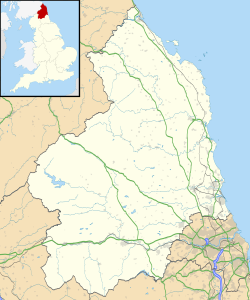Vindobala (Brytonnic Celtic : windo- fair, white, bala place, situation?, cf. Old Irish bal, bail place, situation, condition, good luck) was a Roman fort with the modern name, and in the hamlet of, Rudchester, Northumberland. It was the fourth fort on Hadrian's Wall, and situated about 11 kilometres (6.8 mi) to the west of Condercum (Benwell) fort and 7.5 miles east of Halton Chesters fort. The site of the fort is bisected by the B6318 Military Road, which runs along the route of the wall at that point.
| Vindobala | |
|---|---|
 Site of Vindobala at Rudchester Farm | |
Location in Northumberland | |
| Location | |
| Coordinates | 55°00′04″N 1°49′34″W / 55.001°N 1.826°W |
| Place name | Rudchester |
| County | Northumberland |
| Reference | |
| UK-OSNG reference | NZ112675 |

Description
editThe fort guards the valley of the March Burn to the west, an ancient route leading to the south towards the Tyne ford at Newburn. To the east the ground drops away to the Rudchester Burn. The fort is oblong, measuring 157 metres (515 ft) north to south by 117 metres (384 ft) east to west, and covers about 4.5 acres (1.8 ha). It projected partially north of the wall, typical of a cavalry fort, to allow quick access to the north. There were four main gates with double portals and two smaller, single-portal gates. There was one main gate on the north wall of the fort, and the east and west main gates opened on the north side of the Roman Wall. This left a single main gate on the south wall of the fort, and two smaller gates which probably gave access to a military way running along the south side of the Wall. There were towers at each corner of the fort, and also on either side of the main gates.[1]
It was destroyed by fire and rebuilt on the same plan in the late 2nd/early 3rd century. It became disused by the last quarter of the 3rd century but was re-commissioned c. 370 AD when timber-framed buildings set on stone foundations were erected and occupied till the end of Roman rule.[2]
The Vallum passed about 220 metres (720 ft) south of the fort, and there was a vicus south and south west of the fort. South of the fort, on the brow of a hill, is a cistern, twelve feet long, four and a half feet broad and two feet deep. It was popularly known as the “Giant’s Grave”.
Now there is little to be seen on the surface, apart from mounds to the south of the Military Road marking the west and south ramparts. During the eighteenth and nineteenth centuries stones were systematically removed from the site for local agricultural buildings, and also for the building of the Military Road.
Garrison
editIt is thought that the fort was built for a cohort, 500 strong and part-mounted.
The fort was garrisoned in the fourth century by the First Cohort of Frisiavones. These were troops recruited from a coastal tribe of Lower Germany.
Excavations
editIn 1760 a life-size statue of Hercules was found at the site, which is now in the Great North Museum in nearby Newcastle upon Tyne. Excavations of the site were carried out in 1924 and 1962. Two of the main gateways were excavated, as well as a large granary and part of the headquarters. In addition, a hypocaust belonging to the commandant's house was discovered.[3]
Mithraeum
editIn 1844, five altars, dedicated to Mithras, were discovered near the site, now known as the Rudchester Mithraeum. It is believed that these come from a temple to Mithras, situated to the south east of the fort. It appears that this was built in the third century and was deliberately destroyed in the fourth century. The building was 43 feet (13 m) long and 22 feet (6.7 m) wide with a narthex, or vestibule, attached to the front.
Curtain Wall
editIn 1924, an excavation took place on the wall line 1924 at a point 3 metres (9.8 ft) west of the fort. The north face was erected on a foundation course of coarse white stones. The first course was topped by an elaborately moulded plinth (unknown elsewhere). It has been speculated that this was the location of a special inscription stone marking work on the wall, which has not survived.[4]
References
edit- ^ "Hadrian's Wall - Fort - Vindobala". Roman Britain. Retrieved 12 March 2024.
- ^ "Rudchester Roman Fort (Vindobala)". Tynedale Hadrian's Wall Group. 19 September 2017. Retrieved 12 March 2024.
- ^ "Heritage Gateway - Results". www.heritagegateway.org.uk. Retrieved 12 March 2024.
- ^ Breeze, David J (1934), Handbook to the Roman Wall (14th Revised edition - Nov 2006), Society of Antiquaries of Newcastle upon Tyne, p. 172, ISBN 0-901082-65-1
Sources
edit- Vindobala http://rudchester.org/fort.html
- J. Collingwood Bruce, Roman Wall (1863), Harold Hill & Son, ISBN 0-900463-32-5
- Frank Graham, The Roman Wall, Comprehensive History and Guide (1979), Frank Graham, ISBN 0-85983-140-X
- http://www.roman-britain.co.uk/places/vindobala/
- http://www.hadrians-wall.info/hadrianswall/vindobala/vindobala.htm
External links
edit- Media related to Vindobala (Rudchester) at Wikimedia Commons
